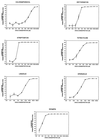Staphylococcus aureus cell extract transcription-translation assay: firefly luciferase reporter system for evaluating protein translation inhibitors
- PMID: 11353649
- PMCID: PMC90569
- DOI: 10.1128/AAC.45.6.1900-1904.2001
Staphylococcus aureus cell extract transcription-translation assay: firefly luciferase reporter system for evaluating protein translation inhibitors
Abstract
The promoter for the Staphylococcus aureus capsule polysaccharide synthesis gene (cap1A) was cloned in front of the firefly luciferase gene for use in a cell extract S. aureus transcription-translation system. The assay is rapid, reproducible, and sensitive and has a lower background level than the radiolabeled amino acid incorporation translation assays. We present data evaluating a transcription inhibitor and a number of protein translation inhibitors in this system.
Figures



References
-
- Mahmood R, Compagnone-Post P, Khan S A. An in vitro coupled transcription-translation system from Staphylococcus aureus. Gene. 1991;106:29–34. - PubMed
-
- National Committee for Clinical Laboratory Standards. Methods for dilution antimicrobial susceptibility tests for bacteria that grow aerobically, 3rd ed. Approved standard M7–A3. Villanova, Pa: National Committee for Clinical Laboratory Standards; 1993.
-
- Novick R N. Genetic systems in Staphylococci. Methods Enzymol. 1991;204:587–636. - PubMed
-
- Ouyang S, Lee C Y. Transcriptional analysis of type 1 capsule genes in Staphylococcus aureus. Mol Microbiol. 1992;6:1515–1522. - PubMed
-
- Zubay G. In vitro synthesis of protein in microbial systems. Annu Rev Genet. 1973;7:267–287. - PubMed
MeSH terms
Substances
LinkOut - more resources
Full Text Sources
Other Literature Sources
Medical
Molecular Biology Databases

